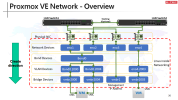Hi,
We're testing PVE as an alternative to ESXi and just trying to wrap our heads around networking in PVE vs ESX.
In ESX, we have 2 x 10Gbps ports (non LACP) connected to a vSwitch which has 3 vmkernel nics (1 for management, 1 for storage and 1 for vMotion) and then multiple port groups (each a different vlan). We simply attach each VM's nic to a portgroup.
I believe that to replicate the above in PVE, we need to create 1 VLAN-aware vmbr with no IP assigned, then create subinterfaces (vmbr0.10 for management with an IP assigned, vmbr0.20 for storage with an IP assigned, vmbr0.30 for phones with no IP assigned, vmbr0.40 for servers with no IP assigned, etc). We then connect each VM's nic to a sub-interface and then specify the VLAN tag. Is this correct?
And more importantly, is this best practice? I've read the admin guide that says PVE prefers LAGs/LACP which requires switch config (not a problem, ours support it), whilst ESX uses NIC teaming (equivlanet to balance-tlb in PVE I think) which does not require any config on the switch side.
Is there any best practice document out there we can take a look at?
We're testing PVE as an alternative to ESXi and just trying to wrap our heads around networking in PVE vs ESX.
In ESX, we have 2 x 10Gbps ports (non LACP) connected to a vSwitch which has 3 vmkernel nics (1 for management, 1 for storage and 1 for vMotion) and then multiple port groups (each a different vlan). We simply attach each VM's nic to a portgroup.
I believe that to replicate the above in PVE, we need to create 1 VLAN-aware vmbr with no IP assigned, then create subinterfaces (vmbr0.10 for management with an IP assigned, vmbr0.20 for storage with an IP assigned, vmbr0.30 for phones with no IP assigned, vmbr0.40 for servers with no IP assigned, etc). We then connect each VM's nic to a sub-interface and then specify the VLAN tag. Is this correct?
And more importantly, is this best practice? I've read the admin guide that says PVE prefers LAGs/LACP which requires switch config (not a problem, ours support it), whilst ESX uses NIC teaming (equivlanet to balance-tlb in PVE I think) which does not require any config on the switch side.
Is there any best practice document out there we can take a look at?


